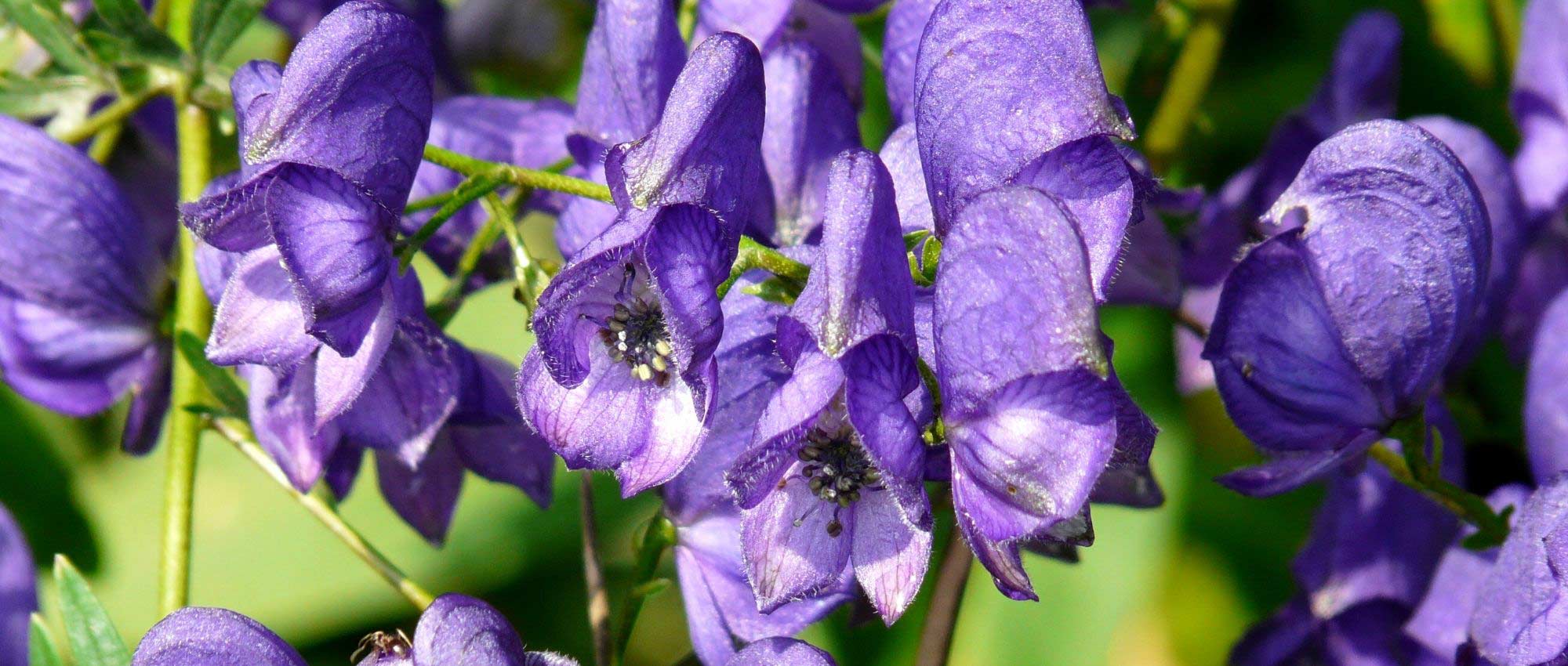
Monk's hood: 7 ideas to combine it in the garden
Create colourful, harmonious flowerbeds!
Contents
Aconitum or Monk’s hoods are perennials that offer superb flowering, which spreads depending on variety from early summer to autumn. They bear flowers gathered in upright clusters, usually a very intense blue, but depending on variety they can also be white or pale yellow. Flowers have an original shape, in the form of a galea, which gives the plant its nickname “Jupiter’s galea”. Very upright inflorescences bring height and verticality to a border. Aconite also has beautiful divided, dark green leaves. They are best grown in partial shade, in rich, moist soil. To combine them in the garden, try monochrome borders in blue or white, or dare to mix colours!
Follow our tips and inspirations to create harmonious scenes.
Harmony of blues
Aconite flowers come in beautiful bluish shades, from the darkest with ‘Spark’s Variety’ to the palest with ‘Stainless Steel’. Create a very harmonious flower bed by combining them with other blue flowering plants! It is a very soft, soothing colour that makes space feel larger (unlike red shades). To avoid monotony, play with the nuances: blue‑violet, lavender, midnight blue, indigo, pale blue – pastel…
Plant aconite alongside campanulas (for example Campanula persicifolia ‘La Belle’): I particularly enjoy their superb bell‑shaped flowers. For a similar style, you can choose Platycodon grandiflorus ‘Mariesii’. Also discover the unusual Clematis integrifolia, which, unlike other clematis, is not climbing! Aconites are also perfect for accompanying the flowering of Delphiniums! Their forms are quite similar, with large upright clusters of blue flowers. You can also enjoy Polemonium caeruleum: a perennial with lovely finely divided foliage and small bell‑shaped flowers. At the front, on the edge of the flower bed, plant fairly low‑growing species, for example hardy geraniums. For shrubs, plant, for example, chaste tree, Vitex agnus‑castus, as well as Hydrangea macrophylla or H. serrata. On the outside of the flower bed, you can incorporate other tones, such as white or mauve, which will create a transition to the rest of the garden.

Aconitum napellus subsp. vulgare (photo Hans Hillewaert) / Clematis integrifolia (photo Michael Wolf) / Hydrangea macrophylla ‘Endless Summer The Original’ (photo Denolf) / Malva sylvestris ‘Primley Blue’ / Campanula persicifolia ‘La Belle’ (photo M’s photography)
To create a very chic white border!
Some varieties of Aconites offer superb white flowering, allowing you to create an elegant, pared-back border. I highly recommend Aconitum napellus ‘Schneewittttchen’ for its immaculate white flowering. Pair it with Clematis ‘White Pearl’, Persicaria amplexicaulis ‘Alba’, Astrantias, Campanula persicifolia ‘Alba’, or Astilbe arendsii, which bears superb feathery inflorescences. Discover also the delicate, very fine white spikes of Lysimachia fortunei! You can incorporate variegated foliage, such as that of Hostas or Carex morrowii ‘Ice Dance’. Also appreciated is Aegopodium podagraria ‘Variegata’, which offers both variegated foliage and white flowering in very delicate umbels. Don’t hesitate to frame the border with, for example, box or yew hedging. The whiteness of the flowers will stand out beautifully against green foliage! In partial shade, this scene will bring exceptional brightness, giving a sense of purity and refinement. To maintain this effect, regularly remove faded flowers and damaged leaves so as not to leave room for brown tones that would spoil the border.
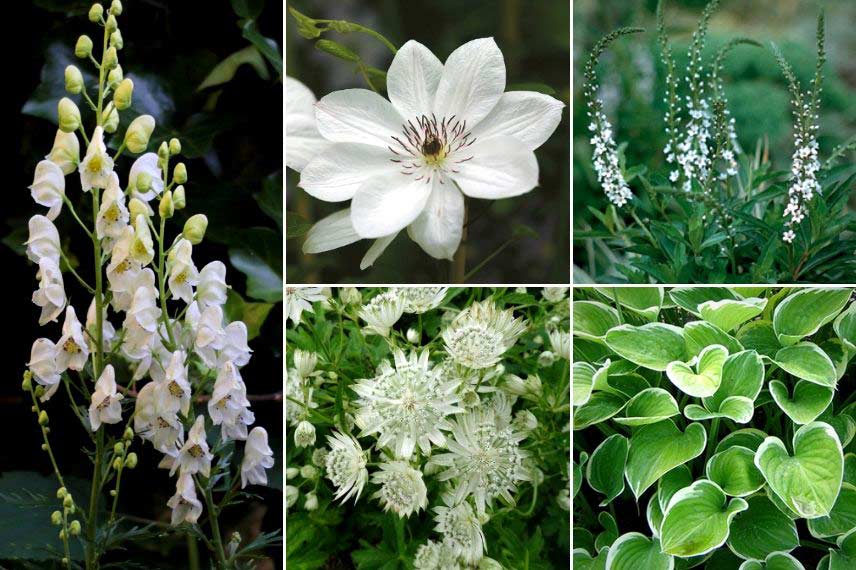
Aconitum ‘Schneewittchen’ / Clematis ‘White Pearl’ / Lysimachia fortunei / Astrantia major ‘Super Star’ / Hosta ‘Clifford’s Forest Fire’
Discover other Aconitum
View all →Available in 0 sizes
Available in 1 sizes
Available in 1 sizes
Available in 1 sizes
Available in 3 sizes
Available in 1 sizes
Available in 1 sizes
Available in 1 sizes
Available in 1 sizes
Available in 1 sizes
To add contrast to a border!
For a striking border, dare to use colour contrasts, by pairing shades that sit opposite one another on the colour wheel. For example, pair the blue flowers of Aconite with orange flowering: Achillea millefolium ‘Terracotta’, Echinacea ‘Orange Skipper’, Belamcanda chinensis, Geum coccineum‘Borisii’, Hemerocallis… Blue and orange are colours that strengthen one another.
Another option to create a highly contrasting border is to pair Aconites bearing white or pale-yellow flowers with dark foliage: Heuchera ‘Obsidian’, Ophiopogon planiscapus ‘Nigrescens’, Physocarpus ‘Midnight’…
Contrasting shapes are also effective: use Aconites to bring verticality and height to a border where plants are fairly low, for example heucheras, hardy geraniums, hostas… For this I particularly recommend Aconite ‘Spark Variety’, which reaches up to 1.5 m.
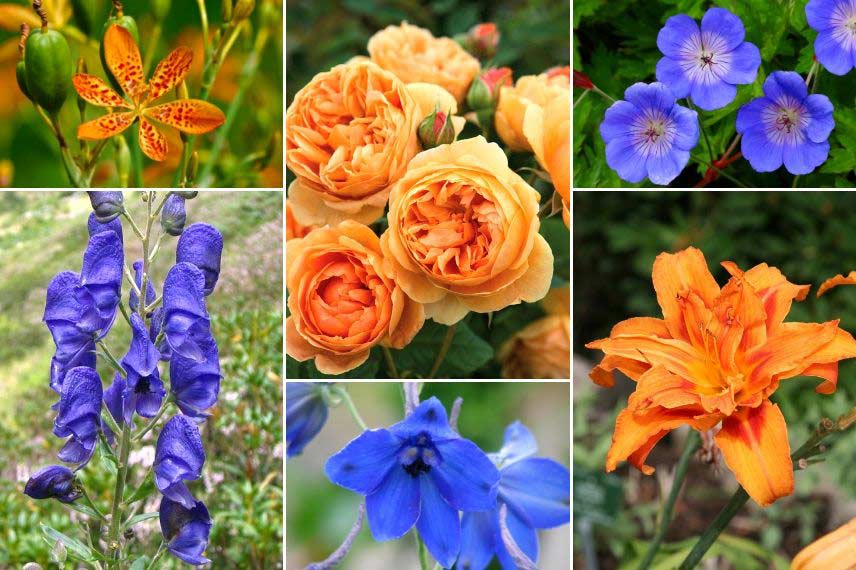
Belamcanda chinensis / English rose ‘Carolyn Knight’ / Geranium ‘Rozanne’ / Aconitum napellus / Delphinium belladonna ‘Völkerfrieden’ (photo Peganum) / Hemerocallis fulva ‘Flore Pleno’
Read also
How to propagate Aconite?In a cottage garden
Create a beautiful cottage garden, with a profusion of flowers and foliage. This type of English garden features borders with a seemingly untidy yet structured look, creating a very romantic, vintage atmosphere. It is traditionally arranged around an old stone or timber-framed house, which it perfectly showcases. Garden style is natural, flowing, with sinuous paths and rounded shapes. To plant the borders, favour soft, pastel shades: pale blue, mauve, white, orange, pale yellow, and plants with a relaxed, free habit… Plants are so generous and abundant that they seem to tumble out of the borders. This garden style expresses nature’s full generosity! In the borders, gather a great diversity of plants: Delphiniums, Phlox paniculata, Geums, Lupins, Oriental poppies, Foxgloves… Also include plants with generous foliage, such as ferns and hostas. Discover the imposing Macleaya cordata, which bears large lobed, grey‑blue leaves. You can also include vegetables and aromatic plants in the borders. Don’t hesitate to add vintage-style decorative elements and wooden furniture… That will add lots of charm to your garden!
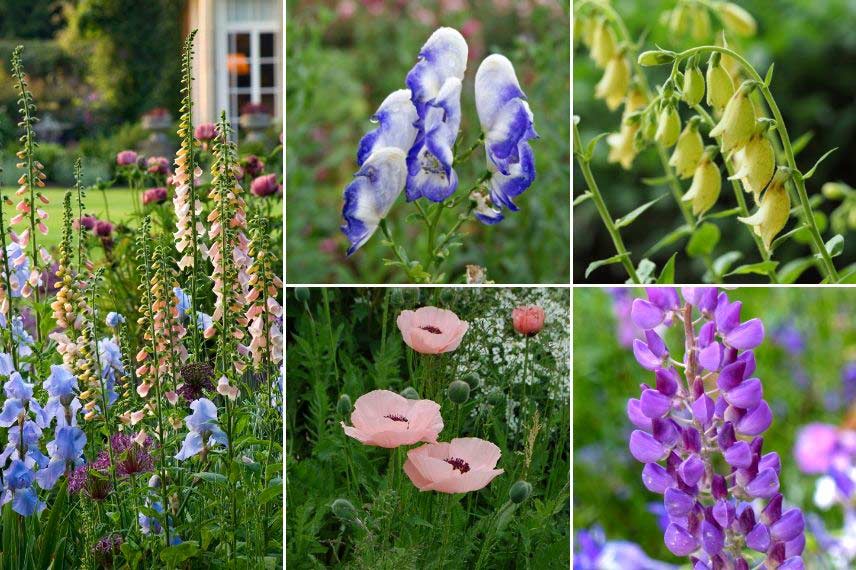
Scene with Iris ‘Jane Phillips’, Digitalis ‘Suttons Apricot’ and Papaver orientale ‘Patty’s Plum’ (photo MAP – The Old Rectory – Haselbech – Northamptonshire) / Aconitum × cammarum (photo Danny Steven S.) / Digitalis grandiflora / Papaver orientale ‘Karine Crambe’ / Lupinus ‘Purple Emperor’
In a romantic garden
Aconites with white or rosy flowers have a delicate quality that fits perfectly in a romantic garden. Choose, for example, Aconitum napellus ‘Schneewittchen’, Aconitum rubellum or aconite ‘Pink Sensation’. Pair them with the elegant flowering of an old-fashioned rose, which you can choose in stronger hues, for example deep red, to set it off. To accompany them, select plants with delicate, soft flowering: clematis, gypsophila, astrantia, foxgloves… Also enjoy the small double, very airy flowers of Thalictrum delavayi ‘Hewitt’s Double’, as well as the long, thin white spikes of Veronica longifolia! Also include large lilies for their very refined look. For foliage, favour plants with silvery leaves, such as artemisia or Stachys byzantina. They have a very soft, calming appearance!
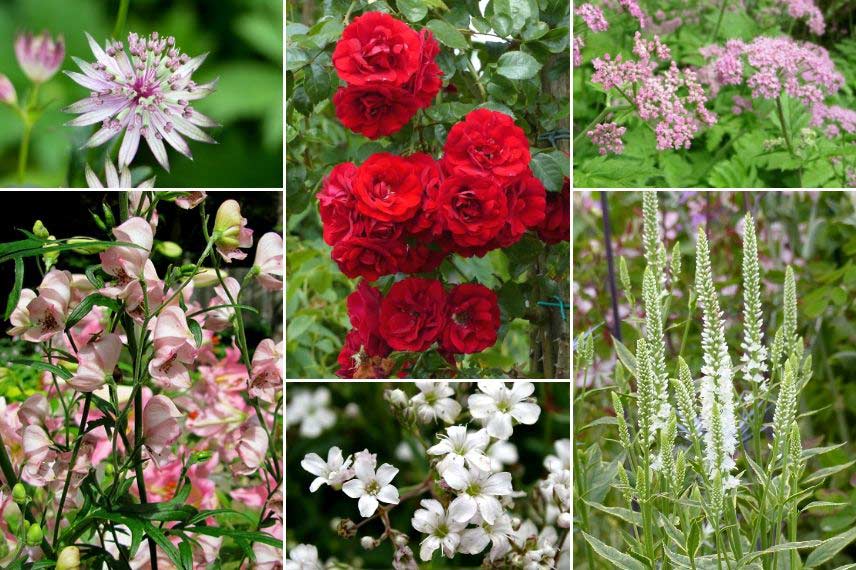
Astrantia major ‘Ruby Star’ / Climbing rose ‘Amadeus’ / Pimpinella major ‘Rosea’ / Aconitum ‘Pink Sensation’ (photo Linda Daley) / Gypsophila repens ‘Alba’ / Veronica longifolia ‘Charlotte’
At the woodland edge
As aconites appreciate semi-shaded positions, you can create a lovely scene at the woodland edge. This will create a very natural atmosphere! Include foxgloves, astrantias, Thalictrum delavayi, Lysimachia punctata… You can also include the Giant Himalayan Lily (Cardiocrinum giganteum) or the imposing umbellifer Selinum wallichianum. Discover the splendid Tricyrtis hirta, also known as toad lily, which bears distinctive white flowers speckled with pink‑purple. With its yellow flowers, Ligularia will add brightness. Consider decorative foliage, such as that of ferns, hostas, Brunnera macrophylla… Rodgersia is also very interesting: this perennial plant forms a tapetum of large, deeply divided leaves, resembling those of horse chestnut.
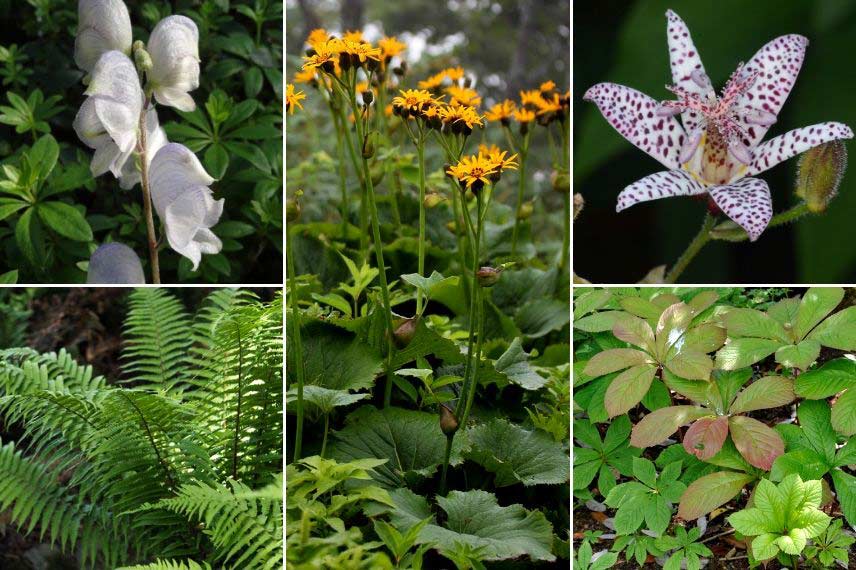
Aconitum ‘Stainless Steel’ / Ligularia dentata (photo Alpsdake) / Tricyrtis formosana x hirta (photo Amada44) / Dryopteris wallichiana / Rodgersia pinnata (photo Megan Hansen)
For a stunning autumnal display!
Late-flowering aconites will fit perfectly into a border in autumnal colours! Choose, for example, Aconitum carmichaelii ‘Arendsii’, which flowers in September–October. For a beautiful autumnal atmosphere, favour warm hues: purple, orange, copper-red, golden, yellow… but avoid colours that are too pale or bright. Choose Asters amellus, Japanese anemones, Eupatorium, Echinacea purpurea… Plant tall ornamental grasses at the back of the border: Miscanthus, Cortaderia, Calamagrostis… It is interesting to pair them with trees whose leaves take beautiful autumnal colours: Liquidambar, Cercidiphyllum japonicum, Parrotia persica, Euonymus planipes… You will achieve a lovely late-season atmosphere!
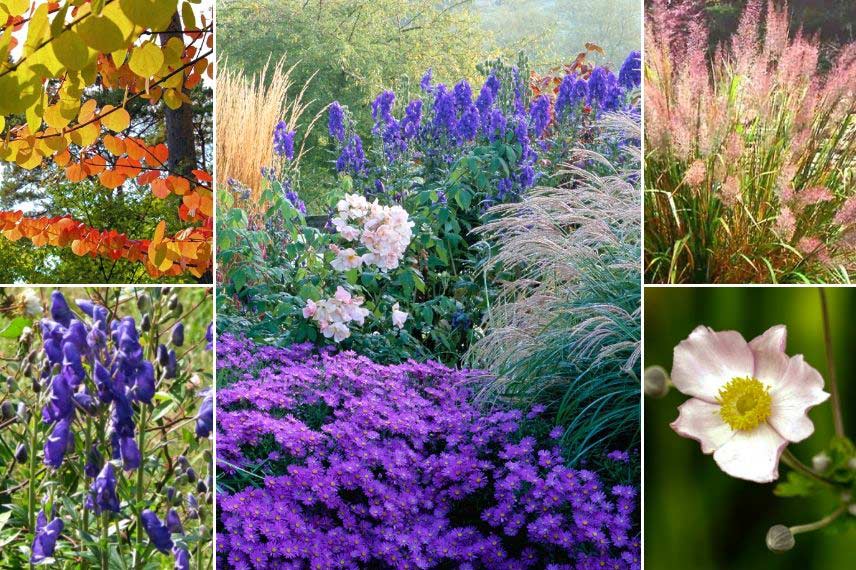
Cercidiphyllum japonicum / Scene with Aconitum carmichaelii ‘Arendsii’, Calamagrostis ‘Karl Foerster’, Miscanthus and Aster amellus ‘Sonora’ (copyright MAP – Clive Nichols – Pettifers Garden Oxfordshire) / Calamagrostis brachytricha / Aconitum carmichaelii ‘Kelmscott’ (photo Peganum) / Japanese anemone ‘Robustissima’ (photo Thomas)
- Subscribe!
- Contents
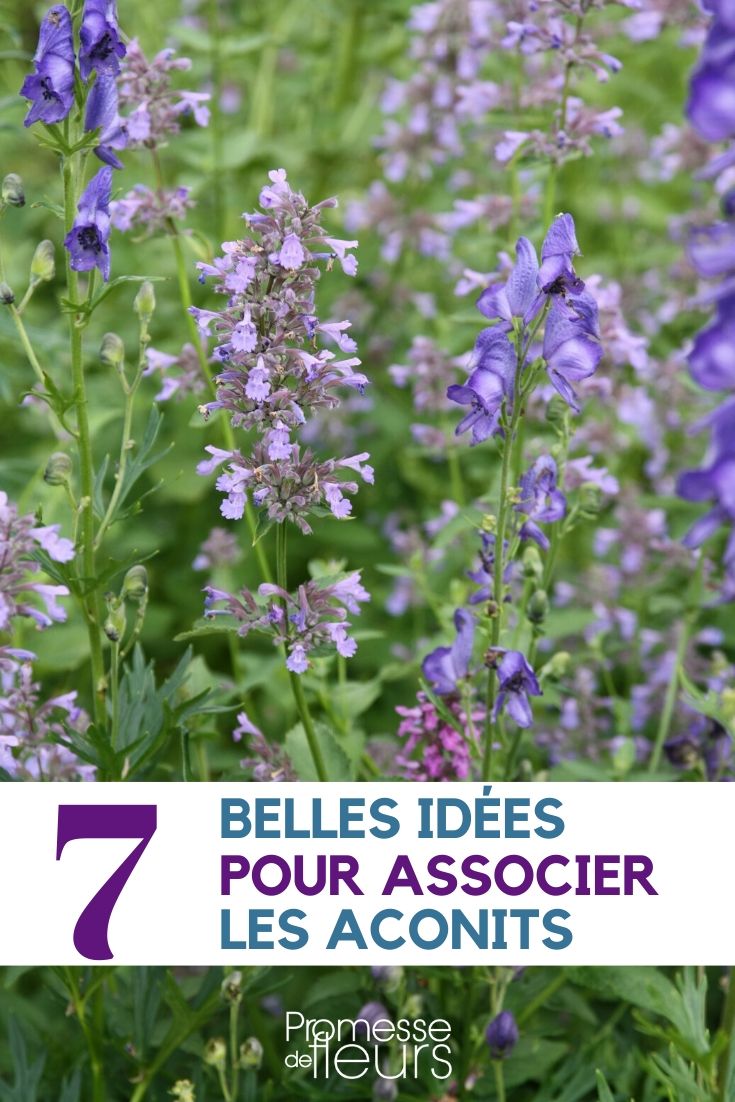































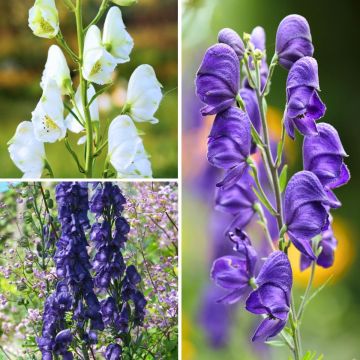
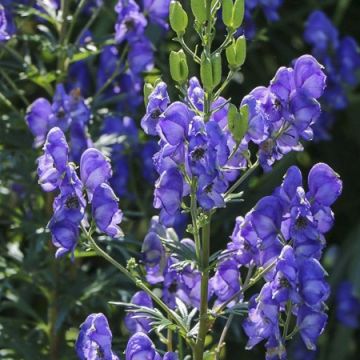
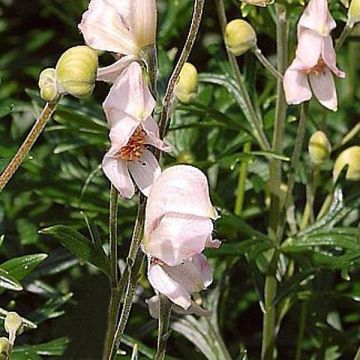
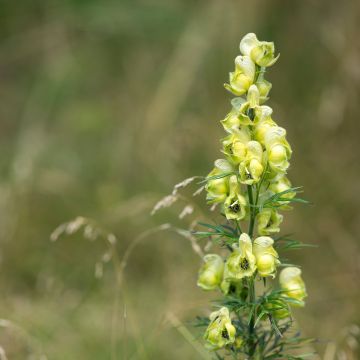
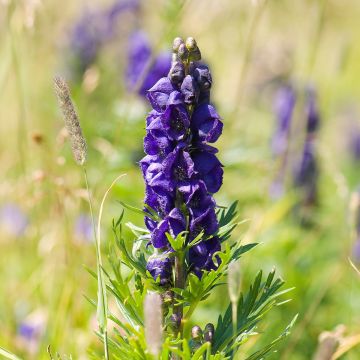
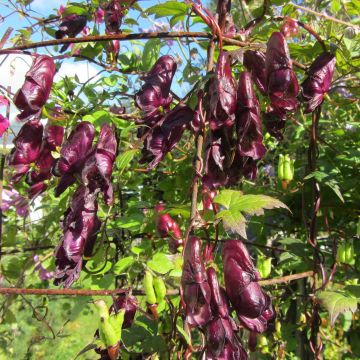
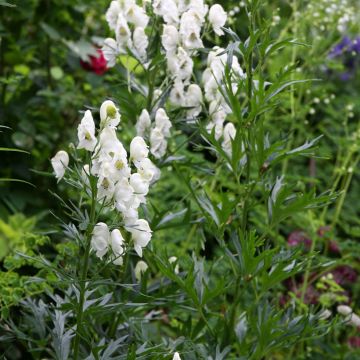
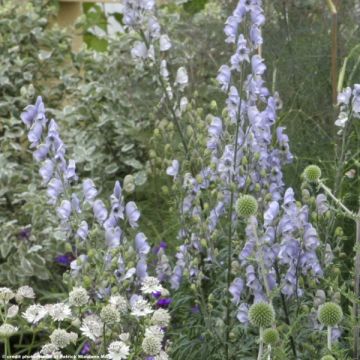
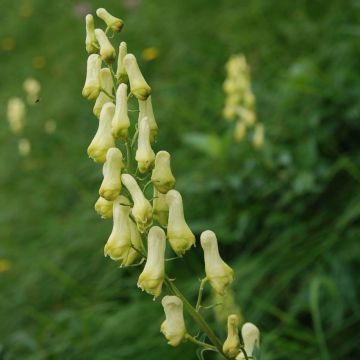
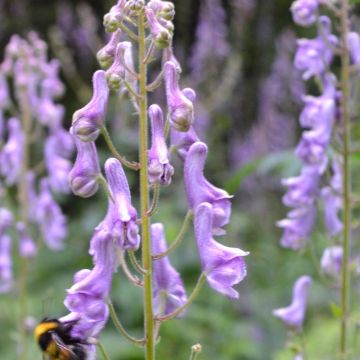
Comments